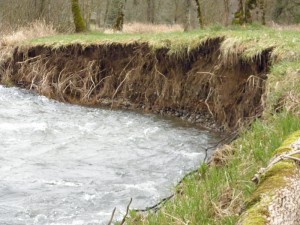Streambank erosion is a natural process and, in an undisturbed stream, it usually happens slowly over time. However, once a stream is disturbed and plants along streambanks are removed, this process may speed up to alarming rates of erosion.
Increased flow in our many rivers and streams due to winter storms and snow melt can increase erosion along areas that are already unstable. This can lead to property loss, poor water quality, and loss of healthy conditions for fish. We have all seen erosion cause property loss with large chunks of bank slumping and toppling into the stream following each large rain storm.
How do I fix it?
One way to help repair these serious erosion problems (or prevent them in the future) is to plant trees, shrubs, and grasses in the area along the stream known as a riparian area. Healthy plants covering the streambanks and the area next to the stream will serve to protect water quality, provide habitat for fish and wildlife, and stabilize streambanks.
Now is the time to start planning your streambank project. When deciding what plants to use, it is a good idea to think about using native plants. Native plants are adapted to our local soils and moisture conditions, and provide food and habitat for our native wildlife. Some of the best shrubs for the riparian area are native willows like Pacific and Scouler’s willow or Red Osier Dogwood, which can be recognized by its bright red stems and small white flowers. Native trees to consider are Oregon Ash and Red Alder. Willows and dogwood form dense hedges with fibrous roots, which can greatly reduce water speed, in turn slowing down erosion. Oregon Ash also has a very strong root system that is excellent at holding soil in place. Check here for native plants sales in our area.
The best time to plant trees and shrubs is when they are not actively growing, typically between November and March. If you live in an area with beaver, mice, or other wildlife, it may be necessary to protect your plantings with tree protection tubes. Keeping the ground around each planting free from competing grass and other plants will also help reduce wildlife damage.
While adding native plants typically reduces streambank erosion, in more extreme erosion cases, such as when banks are steep, planting trees and shrubs may not be enough to stabilize the streambank. When this occurs, other techniques may be necessary to control the erosion.
Where will I find help?
The Clackamas Soil and Water Conservation District can provide on-site technical advice to assist you with protecting and restoring your streamside area. For more information on streambank restoration in Clackamas County, contact us at 503-210-6000.


